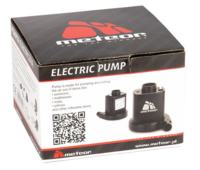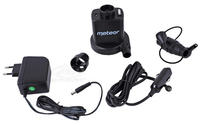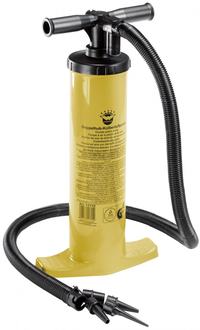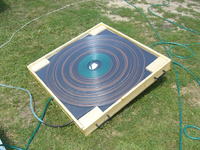
Hello to all forum members.
Phew how hot. ;-)
Today I would like to present you my holiday construction, it has little to do with electronics, but I think it is an interesting solution for summer heat.
Let's start from the beginning.
The project was inspired by the topic of heating a garden pool described on the electrode portal.
https://www.elektroda.pl/rtvforum/topic2594299.html
As my daughter likes to splash in the pool, I have been constantly pumping the pool for the summer for several years. As you know - kids like water very much and if it weren't for their parents, they probably wouldn't leave it from morning to evening, but let's get to the point.
To begin with, I put the first pool I bought and inflated on polystyrene - first, so that the child would not sit in it directly on the ground, and second, so that the water would not cool down too quickly - it is always thermal insulation from the ground. After pouring the water (not much, the pool is about 150 cm in diameter, the water height is 10 cm, blue in the photos), I noticed that the water in such a pool is not warm at all after a whole sunny day and a longer session ended with a hoarse voice and a summer runny nose. At that time, I was already looking on the internet to solve this problem and I came across this topic on the electrode, the link to which I gave above. Of course, I began to wonder how to use this information for my purpose.
Reading this topic, and it was just in the summer, I immediately decided to check how a simple solar collector can be made to heat the pool water.
In a matter of minutes, I had my pool water heater initially set up, and it was supposed to work like this:
As a heating element for the water, I used a garden hose, which I connected on one side to a 12V bilge pump. I immersed both the pump and the other end of the hose in the pool. I wrapped the snake in a circle so that it took up little space and covered it with a glass. Under the hose there is an underlay, such as is placed under the floor panels, it is always some kind of thermal insulation from the ground.
I didn't buy anything, the preliminary design was made of the things I had at hand.
The pump is powered by a battery and a solar battery connected in parallel to the battery - fast version without a charging regulator.
Initial version - photo below.
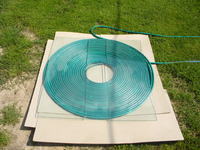
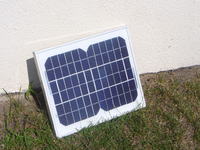
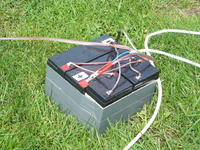
And throughout the sunny and warm day, the water around 3 p.m. - 4 p.m. was as warm as for bathing in a tub.
It motivated me to continue my work.
At that time, I made a wooden frame, padded wooden boards on the bottom and wooden board, polystyrene is cut 5 cm thick on the felt, red sheet metal and a garden hose, all covered with glass. I also had all the materials and a few hours later the first water heating collector was built.
Below are photos of the collector I did in 2014
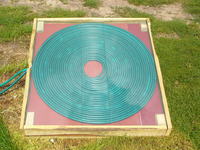
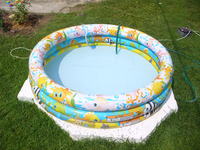
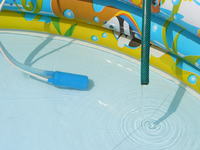
As I was using the same manifold a year back, because unfortunately I had a short vacation and there was not enough time for anymodernizations, so this year I decided to make it from scratch - I invested a bit, but the effect is both visual and practical.
I started working on the new collector at the beginning of June (after work - after hours).
First, the purchase of planed boards, then something like a drawer was assembled from these boards - I also mounted four furniture handles so that the collector could be easily moved by two people.
Dimensions are 104cm x 104cm - inside 100cm x 100cm
Later painting with 4x primer and 3x yacht lacquers, of course at appropriate intervals.
Then inside it is lined with 5 cm thick polystyrene - I put a black flat sheet on it and I put a new black garden hose - 50m 1/2 inch - as you can see in the first photo, 50 meters is a little bit, so I added a few more meters of green I had. The whole thing is covered with a glass, the black hose is the collector's entrance and the water from the pump is supplied there. The green one is the exit and runs under the polystyrene sheet and then returns to the pool. The glass rests on four boards on the sides and on the hose, lies evenly and is not too hot during operation, because the hose cools the temperature inside the collector on an ongoing basis. If it is not used, it is covered with, for the time being, a makeshift gumolite. I am currently making a cover, i.e. an OSB board with dimensions of 108 cm x 108 cm - covered with epoxy resin to make it resistant to weather conditions. There will be a sheet of metal on the outside, the same boards underneath as on the corners, so if you put it on the glass, it will fit.
Here are some assembly photos.
At the beginning, the "drawer" with handles:
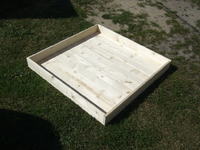
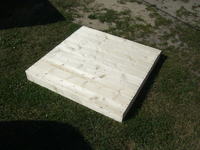
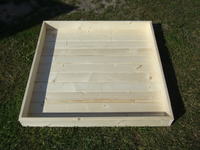
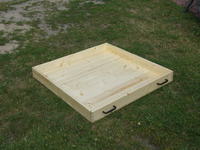
In the next stage, varnishing, polystyrene and sheet metal:
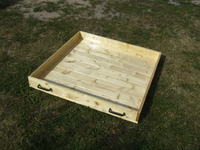
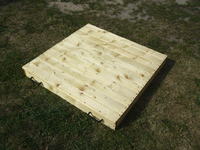
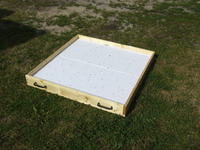
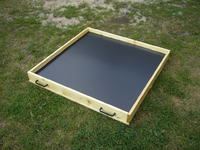
It took a bit of work, but the effect is there - photos of the finished collector below:
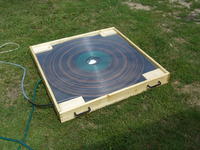
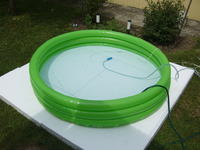
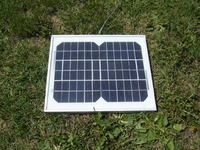
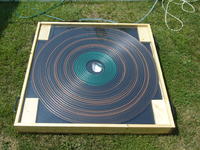
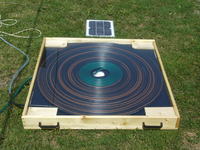

And now some practical tips and measurements, I think everyone will be interested.
As I mentioned before - the principle of operation is very simple - this time the submersible pump is connected directly to the solar battery and when the sun is out, the pump pumps water into the hose in the collector there, under the glass, the water in the hose heats up and the other end of the hose flows into the pool.
At this point, I warn everyone who would like to do something like this before using a 230V pump. I am allergic to human thoughtlessness and I would not forgive myself if there was some kind of overvoltage when my child was sitting in the pool. I STRONGLY ADVISE against it, because it is associated with a potential threat to life.
That's why I used a 12V submersible pump - used for camping - the pump takes about 1.6A from the battery, which givesabout 20W and with this power it can pump 10l / min, but it has a minus, namely it cannot work continuously, only probably a maximum of 10-15 minutes. In my system - a very simple one, the pump is powered directly from a 10W solar battery, so it works at half its power, thanks to which we gain the possibility of continuous operation and lower flow, which in our case is very beneficial.
The connection method without any drivers also has its advantages: simple analog operation - the sun is on, the collector is warm; there is no sun, the collector does not heat up, the pump stops and the water circulation stops, which also helps to prevent the pump from unnecessarily giving hot water to the collector when the sun is behind the clouds.
I also warn you against using a SMPS Made In China power supply for such a pump - I do not trust these Chinese products. God forbid such a power supply will get a breakdown and the electricity from the mains will go to the pump and to the water, and then you know what to do next.
So far my solution is 100% safe, effective and ecological.
As I mentioned earlier - in the collector with internal dimensions of 100cm x 100cm there is 50m of black hose and a few green ones, about 5m - as there is no high pressure in the hose, the hoses were pressed inside with a smaller one with a smaller thickness along the length of about 4 cm - the thinner hose that fits on the pump, just perfectly fits inside the half-inch hose. The temperature difference between inlet and outlet is from 3 degrees for cold water to 6 degrees for warm water.
A few photos from inlet and outlet measurements.
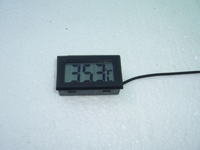
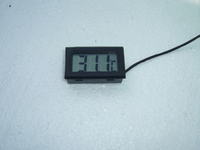
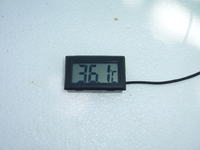
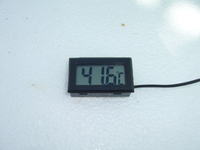
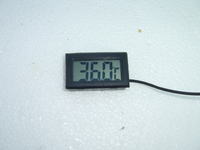
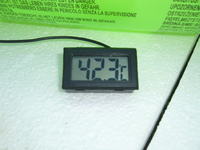
You can see for yourself what the temperature difference is - at the moment I have this green pool with a diameter of 180 cm, the water height is 10 cm, so not so little water and the collector did very well, the temperature reached over 35 degrees, as you can see in the pictures above.
And by the way, it was not without obstacles when pumping the pool - I must mention it, because recently I bought a small 12V car compressor for pumping pools, beach balls, wheels from bicycles and cars - just a revelation for less than PLN 20. I would like to add that it is a Chinese revelation, and I have a growing disgust with cheap Chinese products.
Until now, I had a foot pump, but as you know - you have to pump a lot to inflate such a pool, so I bought this compressor - connected to the battery and started to pump - after about 5 minutes it got smoked and the compressor died - so I gave it back sooner to the market - they gave the money back without any problems.
Photo of this miracle before self-ignition - I do not recommend it.
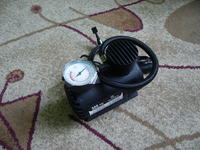
Well, I was left without a push-up, I was either leg pumping or ... you have to figure something out, and as I like to combine, I had another challenge.
Fortunately, there was an old refrigerator in the garage - it is probably 40 years old, but after plugging in, a smile appeared on my face - it worked.
40 minutes later it looked like this and was adapted to pumping the pool and more.
Photo below.
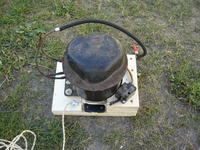
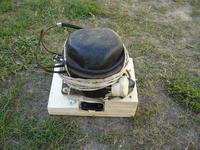
After the season, the collector will be tucked against the wall inside the garage and it will be waiting for the next season. I have only one problem - how to effectively pump out the water for the winter here, because an unheated garage and water left in the hose at negative temperatures will lead to the hose bursting - maybe some ideas? I will be grateful for the hints.
In case you had any questions, I'll be glad to help. I am waiting for comments, this is my seventeenth published project - please be understanding, I read the regulations and I think that I did everything in accordance with them.
Cool? Ranking DIY






